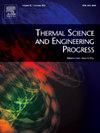Design and experiment of thermal control system for solar extreme Ultraviolet imager
IF 5.1
3区 工程技术
Q2 ENERGY & FUELS
引用次数: 0
Abstract
This paper introduces the design and test of the solar extreme ultraviolet imager’s (EUVI) thermal control system. EUVI is used for real-time observation of solar activity and prediction of space weather, with its thermal control system ensuring the stable operation of the equipment in complex space environments. The thermal control system employs a combination of active and passive methods to control the temperature of each component of EUVI. The heat dissipation problem of EUVI in a complex external heat flow environment is solved through detailed external heat flow analysis, thermal design and simulation calculation. The thermal balance test results show that the temperature of the lens barrel assembly is controlled at 20.01 ℃, and the fluctuation range is within 0.3 ℃, which ensures the temperature stability of the optical system. The temperature of the electric box is between 10.11 ℃ and 30.15 ℃, indicating the effectiveness of the thermal control system in dissipating heat under different working conditions. The CMOS temperature can be controlled at 30.01 ℃ in a closed loop, which greatly reduces the influence of temperature fluctuation on CMOS imaging quality. The reliability of the thermal control system is verified by the thermal balance test, which guarantees the stable operation of EUVI in the extreme space environment. This study also provides important technical reference and experience accumulation for the design of thermal control systems of space instruments and promotes the development of space thermal control technology.
太阳极紫外成像仪热控系统的设计与实验
介绍了太阳极紫外成像仪(EUVI)热控系统的设计与测试。EUVI用于实时观测太阳活动和预测空间天气,其热控系统保证了设备在复杂空间环境下的稳定运行。热控制系统采用主动和被动相结合的方法来控制EUVI的每个组件的温度。通过详细的外热流分析、热设计和仿真计算,解决了EUVI在复杂外热流环境下的散热问题。热平衡测试结果表明,透镜筒组件温度控制在20.01℃,波动范围在0.3℃以内,保证了光学系统的温度稳定性。电箱温度在10.11℃~ 30.15℃之间,说明了不同工况下热控系统散热的有效性。CMOS温度可以闭环控制在30.01℃,大大降低了温度波动对CMOS成像质量的影响。通过热平衡试验验证了热控系统的可靠性,保证了EUVI在极端空间环境下的稳定运行。该研究为空间仪器热控系统的设计提供了重要的技术参考和经验积累,促进了空间热控技术的发展。
本文章由计算机程序翻译,如有差异,请以英文原文为准。
求助全文
约1分钟内获得全文
求助全文
来源期刊

Thermal Science and Engineering Progress
Chemical Engineering-Fluid Flow and Transfer Processes
CiteScore
7.20
自引率
10.40%
发文量
327
审稿时长
41 days
期刊介绍:
Thermal Science and Engineering Progress (TSEP) publishes original, high-quality research articles that span activities ranging from fundamental scientific research and discussion of the more controversial thermodynamic theories, to developments in thermal engineering that are in many instances examples of the way scientists and engineers are addressing the challenges facing a growing population – smart cities and global warming – maximising thermodynamic efficiencies and minimising all heat losses. It is intended that these will be of current relevance and interest to industry, academia and other practitioners. It is evident that many specialised journals in thermal and, to some extent, in fluid disciplines tend to focus on topics that can be classified as fundamental in nature, or are ‘applied’ and near-market. Thermal Science and Engineering Progress will bridge the gap between these two areas, allowing authors to make an easy choice, should they or a journal editor feel that their papers are ‘out of scope’ when considering other journals. The range of topics covered by Thermal Science and Engineering Progress addresses the rapid rate of development being made in thermal transfer processes as they affect traditional fields, and important growth in the topical research areas of aerospace, thermal biological and medical systems, electronics and nano-technologies, renewable energy systems, food production (including agriculture), and the need to minimise man-made thermal impacts on climate change. Review articles on appropriate topics for TSEP are encouraged, although until TSEP is fully established, these will be limited in number. Before submitting such articles, please contact one of the Editors, or a member of the Editorial Advisory Board with an outline of your proposal and your expertise in the area of your review.
 求助内容:
求助内容: 应助结果提醒方式:
应助结果提醒方式:


